 Debby Segura
Debby Segura Passover is truly a celebration. It’s a labor of love, but a labor nonetheless. Each year, we clean and shop and prep and cook our way to the seder. As I write out my menus and shopping lists, I make sure I have something for everyone, always blending the traditional with the new. And like every year, I’ll probably make the same classic meat and chicken dishes that most everyone loves, and watch them get eaten to the last morsel.
But this year, I’m planning a quiet shift, a move toward an especially healthy and fresh Passover filled with more vegetables, more crisp and more crunch.
So what led me to this greener Passover? Was it all the winter rains that blessed us and our wildflowers this season? Was it learning from those vegetarian, gluten-free and low-carb guests who graced our table this year? Was it perhaps the memory of a little too much meat and matzo at seders past? Or was it maybe all of the above?
Perhaps this move in a healthy and liberating direction is a little like the Exodus, freeing us from the weight of a heavy cuisine and leading us to a lighter and more natural way to eat. It is my goal to create a meaningful and healthful Passover for everyone, one that is rich in symbolism and yet fresher, lighter and more joyful than ever. Have a healthy, happy Passover, and live it up!
For starters, instead of using lots of little dishes and serving bowls, I’ll serve all of our symbolic seder foods artfully composed on one big board. If you don’t have a big board, a large tray or kale covered cookie sheet pan will work just fine. I’m calling this my Seder Board, not to be confused with the time-honored Seder Plate at the head of the table. This Seder Board will be my centerpiece. It will be placed in the middle of my seder table, for everyone to behold and share, according to the order of the haggadah service. Seder foods vary from one tradition to another, so please use all your favorites.
THE SEDER BOARD
(Serves 10)
1. Karpas and hazeret (vegetables to dip): I like to include fresh Italian parsley (1 to 2 bunches, carefully cleaned), fennel (two large bulbs sliced carefully, plus one small bulb for decoration), celery (separated into stalks, fresh and clean with leaves on or off, according to preference) and dipping liquids in small glass cups: salt water (6 ounces) and Passover apple cider vinegar (6 ounces). (Dipping liquids may vary by tradition. Ashkefardically speaking, we’ll include both Ashkenazi salt water and Balkan/Ladino Sephardic vinegar.
2. Maror (bitter herbs): Romaine lettuce (two large heads of carefully cleaned whole leaves), one head of separated green endive leaves and one head of separated red endive leaves or Treviso (if you can find Treviso, it’s more dramatic). And for a huge jolt of color, include red horseradish. If you use other bitter herbs, display them beautifully, too.
3. Charoset: About 1 cup each of Turkish charoset and Lebanese charoset (recipes for each version to follow).
4. Eggs: White and mahogany hardboiled eggs, one per person. (We eat the usual white hardboiled eggs alongside our special and dramatic-looking mahogany brown eggs that get their rich color by being slowly boiled with lots of brown onion skins.)
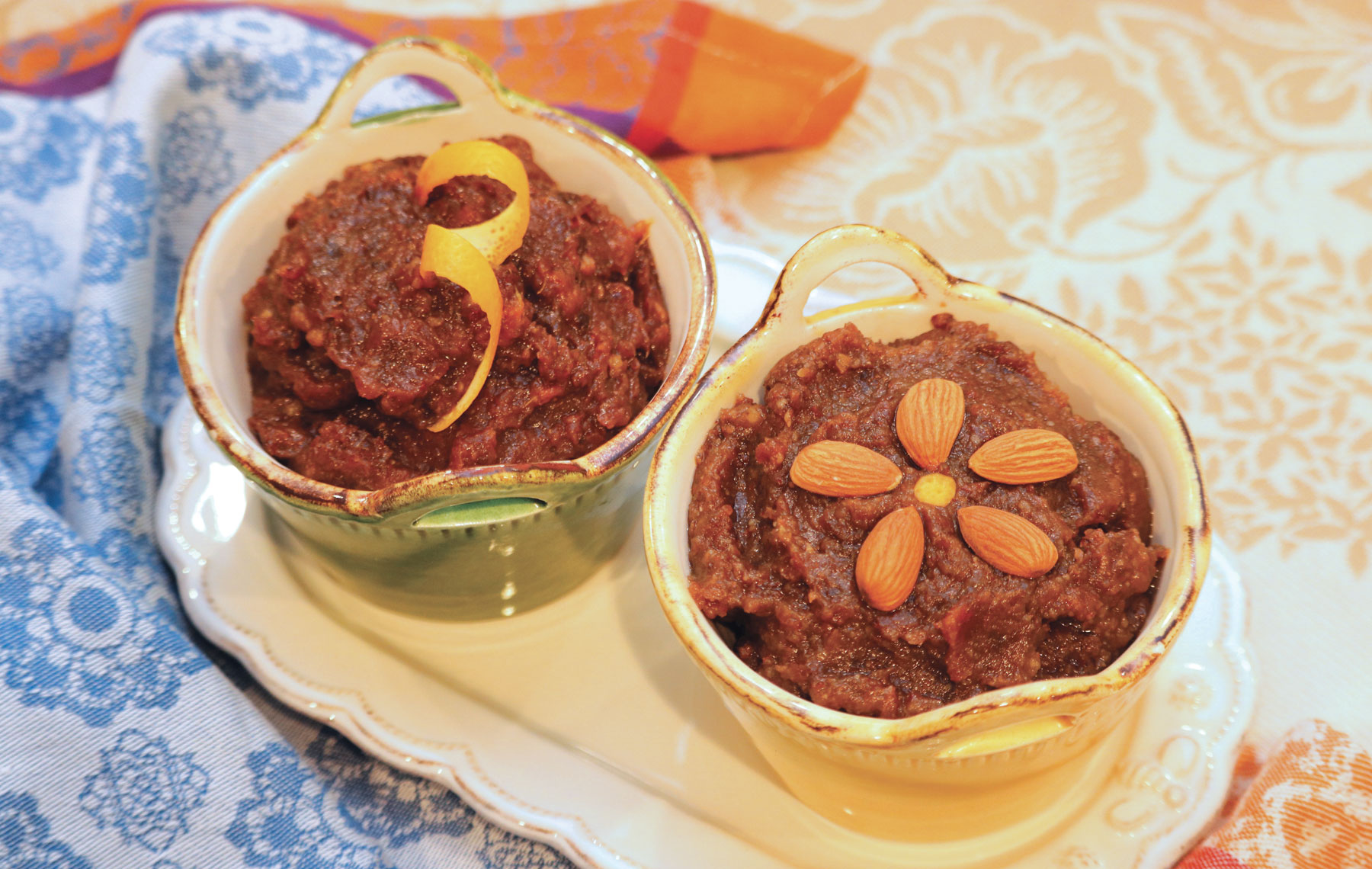
Turkish and Lebanese Charoset
TURKISH CHAROSET(Adapted from “Sephardic Holiday Cooking,” by Gilda Angel)
1 pound pitted dates, checked and coarsely chopped
1 cup seedless black raisins, soaked and rinsed
1/2 cup pitted prunes
1/2 cup dried or fresh apricots
1/2 cup sugar (optional)
1 green apple, peeled, cored and cubed
1 orange, peeled, pitted and cubed
2 tablespoons lemon juice or 1 tablespoon Passover apple cider vinegar
2 tablespoons water
1/2 teaspoon ground cinnamon
1/2 cup coarsely ground walnuts
In a saucepan, combine the dates, raisins, prunes, apricots, sugar (optional), apple and orange cubes, lemon juice or vinegar, water and cinnamon. Cook over low heat, stirring often, until the charoset is soft, about 20 minutes. Add an additional tablespoon of water here and there if necessary to prevent the charoset from sticking to the pan and burning. Remove from the heat and stir in the walnuts. Coarsely chop in a food processor to create a chunky paste (this symbolizes mortar). This may be frozen.
Garnish with a big curl of orange or lemon zest.
Makes about 1 1/2 quarts.
LEBANESE CHAROSET
1/2 pound pitted dates, checked and coarsely chopped
1/2 pound seedless black raisins, rinsed
Water
Walnut halves or blanched almonds for garnish (optional)
Rinse the raisins and dates thoroughly with cold water. Drain. Combine the raisins and dates in a large bowl with 2 or more cups of water, to cover. Cover the bowl with plastic wrap and allow the fruit to soak about 8 hours or overnight.
By morning, the fruit will have absorbed all of the water. If there is excess juice, reserve it.
Place the fruit in a sauce pan and simmer until the liquid has evaporated, leaving a jam-like mixture. Cool.
Place the cooked fruit in the work bowl of a food processor and pulse until the charoset is coarsely but uniformly chopped. If the mixture seems too thick, thin with some of the reserved juice, adding a teaspoon at a time. Cover and refrigerate for at least one hour, or up to three days, before serving. Serve at room temperature.
Garnish with walnut halves or blanched almonds. This may be frozen.
Makes about 1 pint.
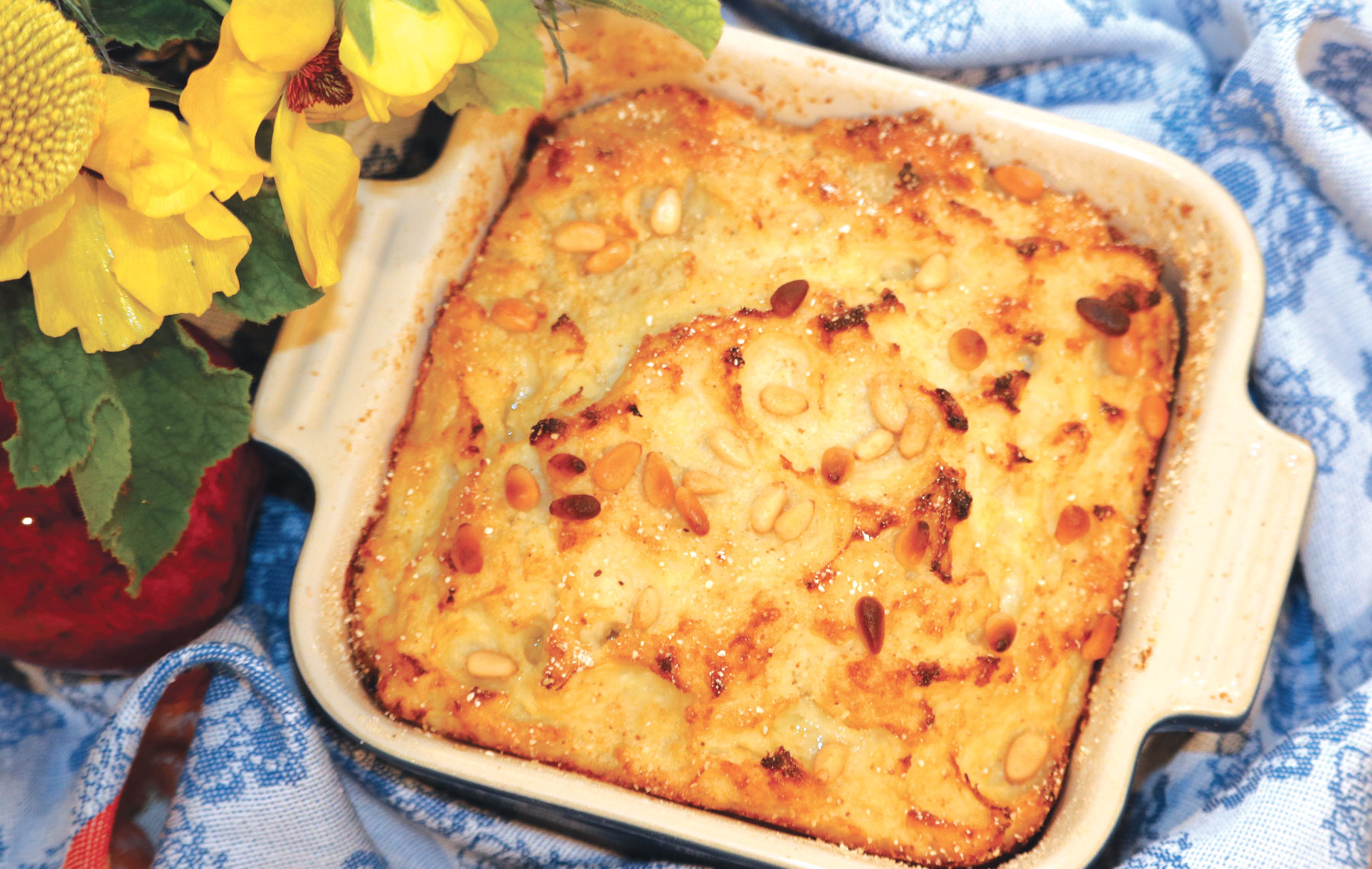
Pasticcio di Cavofiore
Pasticcio is about as close to kugel as we get in my Ashkephardic home. Instead of lots of eggs and margarine or oil, this kugel has no eggs and only a little olive oil. It’s low in carbohydrates, and the recipe can be doubled or tripled. The pasticcio can be frozen to be thawed and reheated later. It can be served with meat entrees such as brisket or chicken, or topped with a hearty vegetarian sauté such as shallots, cremini and shiitake mushrooms, with Italian parsley and garlic.
PASTICCIO DI CAVOFIORE (CAULIFLOWER PIE)
(Adapted from “The Classic Cuisine of the Italian Jews,” by Etta Servi Machlin)
2 large or 4 small heads of cauliflower, washed, trimmed and separated into separate florets; cut stems into 1/2-inch cubes
2 tablespoons olive oil, plus oil to grease the pans
3 cloves minced garlic
Kosher salt, to taste
White or cayenne pepper, to taste
2 eggs and 2 egg whites
2 tablespoons matzo cake meal (optional, for gluten free)
2 tablespoons matzo meal (optional for gluten free)
1 tablespoon pine nuts (optional garnish)
Steam the cauliflower pieces at a simmer until tender, about 20-25 minutes, drain and reserve.
In a deep frying pan, gently heat the olive oil and add the minced garlic. Sauté until the garlic just begins to give off its fragrance, being careful not to let it color. Add the steamed cauliflower and mash it with a potato masher or fork until it forms a slightly lumpy puree. Continue cooking the puree until the liquid has evaporated and it is very thick. Season to taste with kosher salt and white or cayenne pepper.
Preheat the oven to 425 F.
Slightly beat eggs and egg whites to blend. Add the beaten eggs and matzo cake meal to the cauliflower puree and stir to combine.
Grease two pie pans with olive oil and dust with matzo meal. Spoon the cauliflower mixture into the prepared pans evenly, dimple the top with the back of a spoon and drizzle with a little olive oil. Sprinkle with matzo meal and pine nuts.
Bake in the center of the oven for about 30 minutes or until golden brown. Pies can be served immediately or reheated before serving. Pies also can be frozen, double wrapped in aluminum foil.
Makes two 9-inch pies, which each serve 8-10.
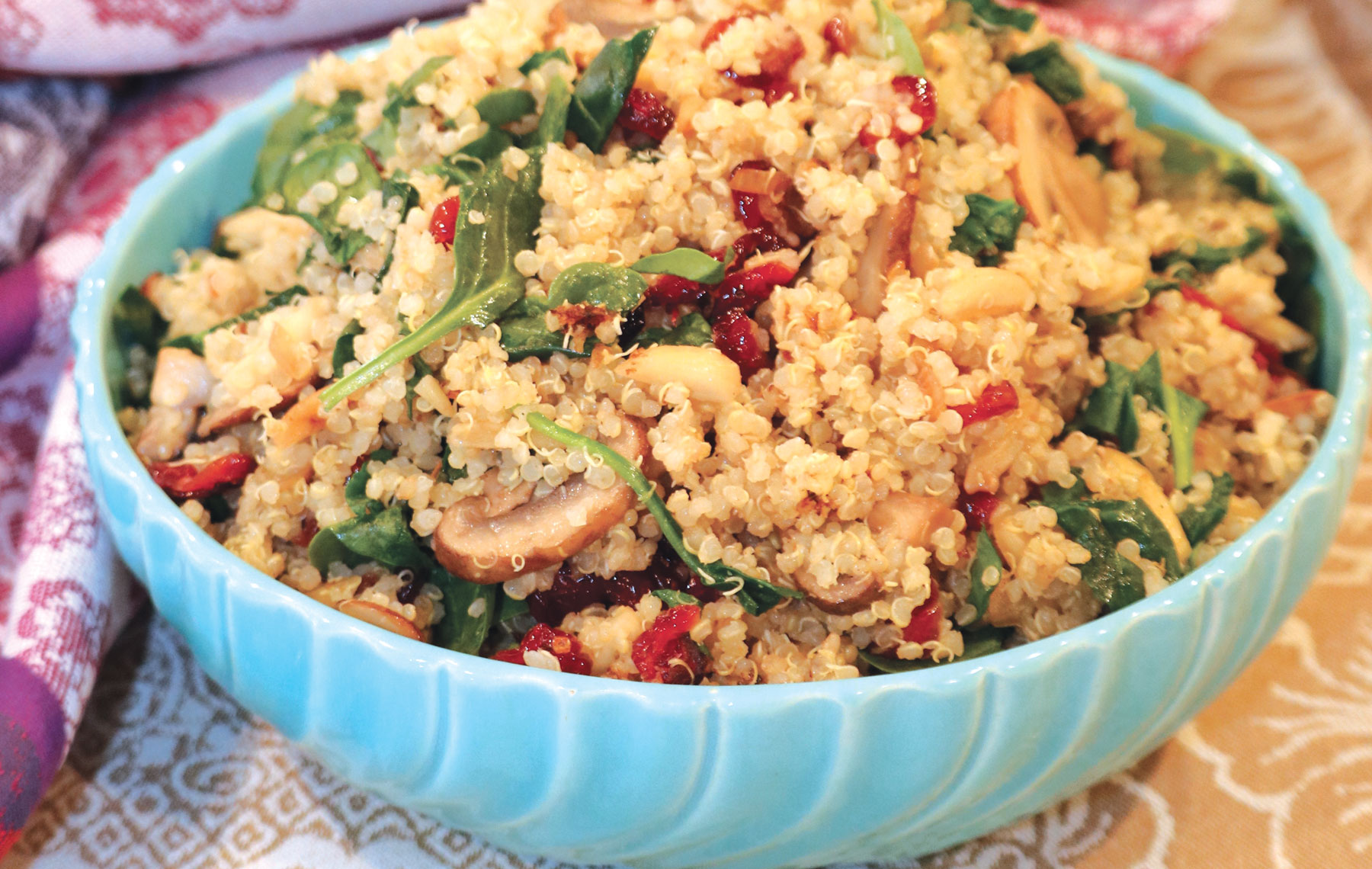
Confetti Quinoa Pilaf
Confetti Quinoa Pilaf is a colorful and versatile choice for people who eat quinoa on Passover. One approach to this kind of pilaf is to make straight quinoa for one meal, and then for the next meal, just sauté the pilaf ingredients and add them to the leftover cooked quinoa. This quinoa can be served alone or topped with a chicken breast or a salmon steak. For a dairy meal, Confetti Quinoa Pilaf can be topped with a fried slab of Halloumi cheese.
CONFETTI QUINOA PILAF
4 cups water
1 teaspoon kosher salt
1 teaspoon onion soup mix (or salt)
1 tablespoon canola oil
2 cups quinoa
2 tablespoons olive oil
1 small brown onion or two shallots, peeled, halved lengthwise and thinly sliced
1/2 teaspoon dried or fresh thyme
1/4 teaspoon chile flakes
1/4 teaspoon minced garlic
1/2 cup dried shiitake mushrooms, rehydrated, cleaned, stems removed or 6 ounces sliced cremini mushrooms
1/2 cup Craisins or raisins
1/2 cup toasted slivered almonds
6 ounces spinach or baby kale leaves, sliced thinly
Salt and pepper, to taste
In a large saucepan, bring water, kosher salt, onion soup mix and canola oil to a boil. Add the quinoa, return to a boil, cover the pot and simmer 20 minutes. Let it rest for 5 minutes, then fluff with a fork. Reserve.
In a large Dutch oven, heat olive oil over a low flame. Add the onion or shallot slices, thyme and chile flakes. Sauté gently until the onions or shallots are translucent and fragrant.
Add the garlic and stir. Add the mushrooms, Craisins or raisins and almonds and stir. Add the cooked quinoa and spinach or kale leaves and stir just enough to heat the quinoa and distribute the spinach. Season to taste. Serve hot or at room temperature.
Serves 8-10.
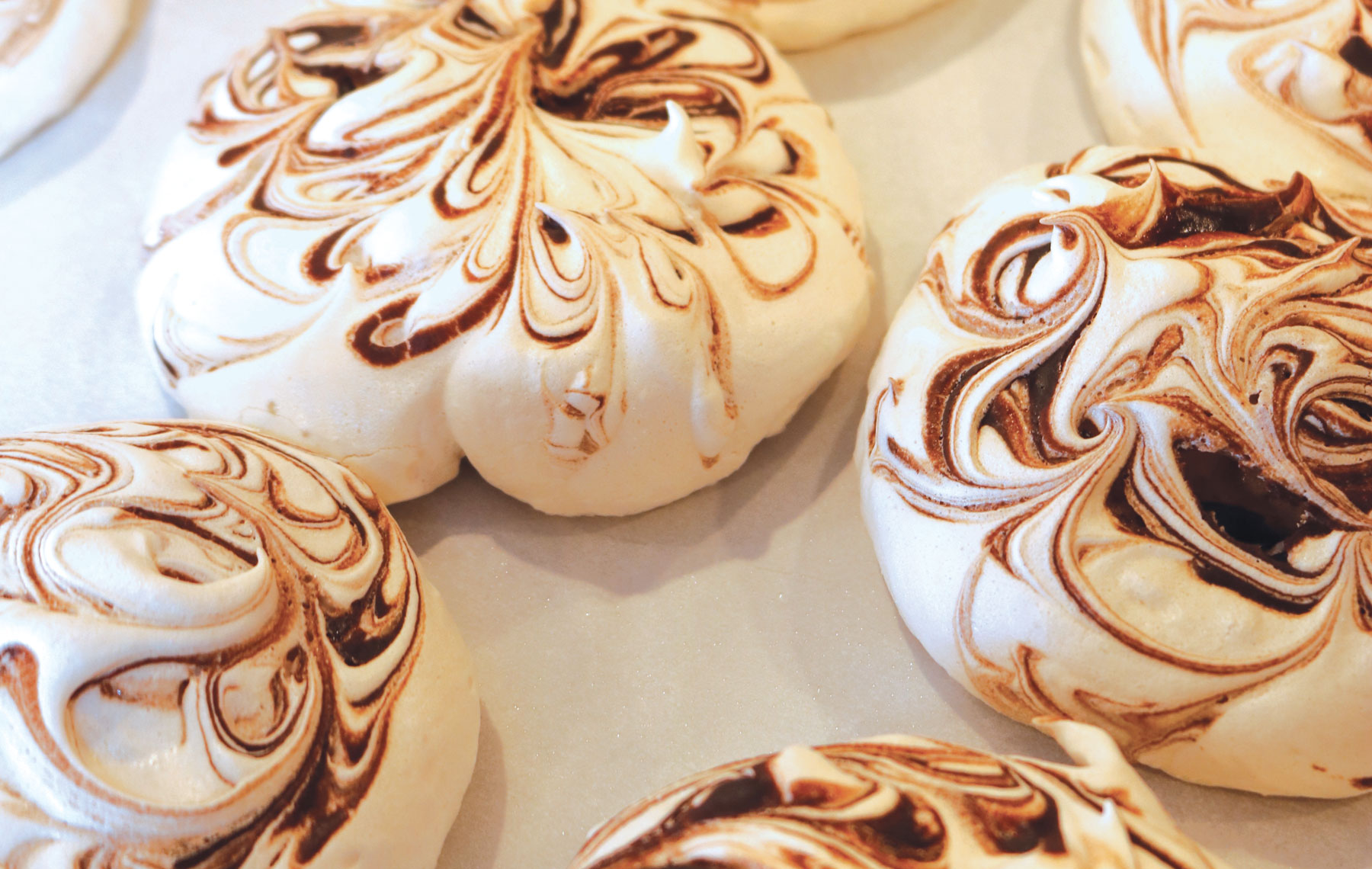
Zebra Meringues
Pareve Custard Cups With Roasted Blueberries are rich little custards that are equally at home in custard cups, small plastic cups, Moroccan tea glasses or small wine glasses. Add this garnish of some roasted blueberries for some ultra-vivid color and a flavor spark. And as long as you’re making those custards, which use only egg yolks, it also makes perfect sense to me to make Zebra Meringues, which use those egg whites.
ZEBRA MERINGUES WITH ORANGE-INFUSED BITTERSWEET CHOCOLATE SWIRLS
MERINGUE:
4 large egg whites, room temperature
1 1/4 cup superfine sugar
Pinch of salt
1/2 teaspoon almond or vanilla extract (or both)
1 teaspoon strained lemon juice or white vinegar
2 tablespoons potato starch
4 tablespoons boiling water
TOPPING:
1/4 cup chocolate chips
2 tablespoons of hot water or coffee
1 large curl of orange zest
Garnishes can include berries, sorbet, ice cream or shavings of bittersweet chocolate.
Preheat oven to 225 F.
Draw one dozen 3-inch circles on the back of a sheet of baking parchment. Flip over the baking parchment, place it on a large baking sheet. Put the parchment on the pan and spray very lightly with non-stick baking spray.
Place all meringue ingredients into the bowl of an electric mixer and beat on high speed until mixture is very stiff and glossy, about 7-10 minutes.
While the meringue is being mixed, place the chocolate chips, orange zest and water or coffee in a small cup and microwave, covered, for 25 seconds. Allow the chocolate mixture to sit for a couple of minutes, remove the rind and whisk chocolate and water together until smooth.
Place a tiny bit of meringue under each corner of the parchment to keep it from moving on the pan.
Working quickly, pipe or spoon 12 mounds of meringue onto prepared parchment. Lightly drizzle each mound with a small amount of the melted chocolate and swirl with a skewer or toothpick.
Bake in the center of the preheated oven for 1 hour, 15 minutes.
Completely cool the meringues and then peel them off the parchment. If placed in an airtight container, the meringues may be stored frozen for up to two weeks.
Makes 12 individual meringues.
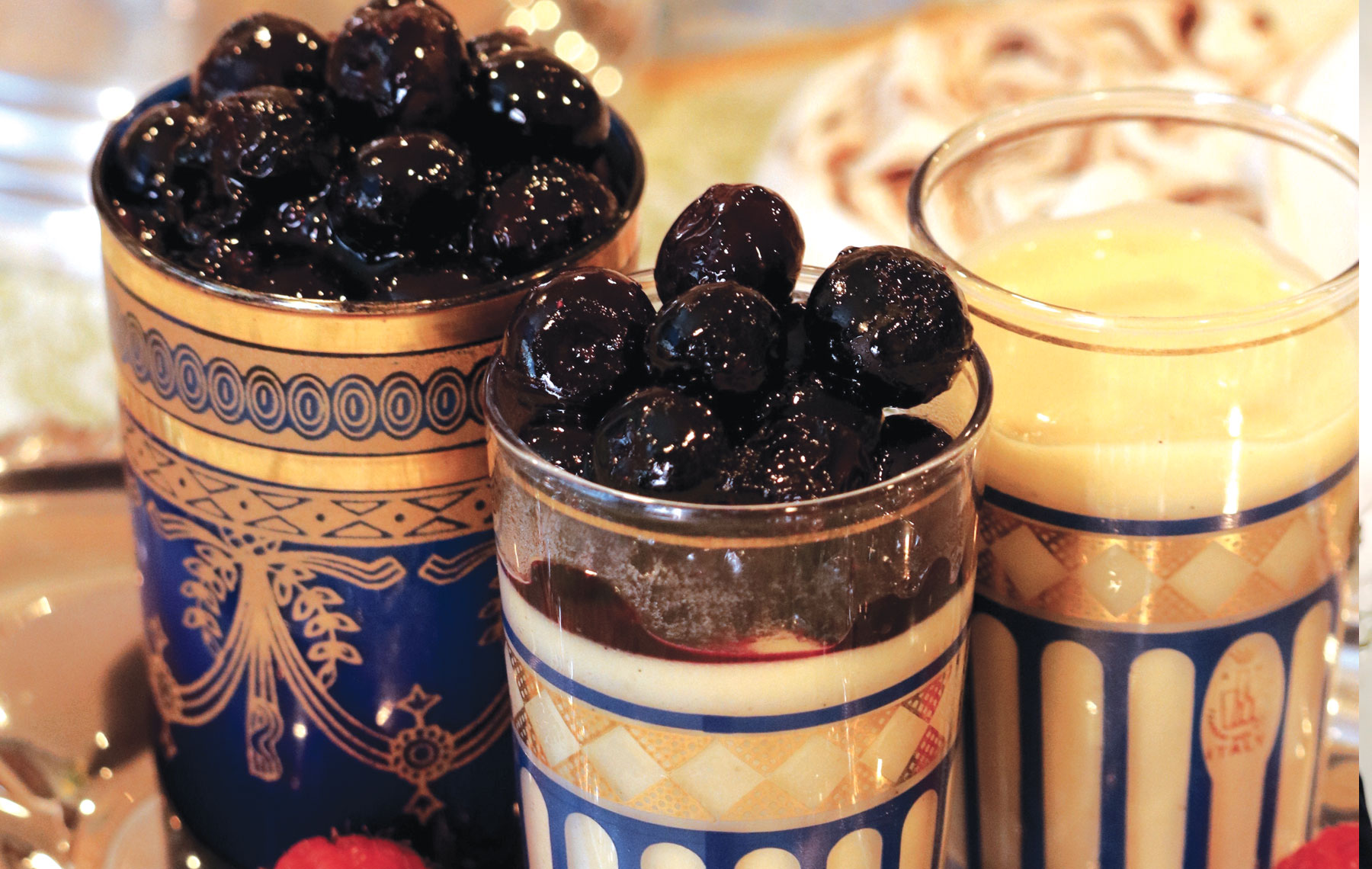
Vanilla Custards With Roasted Blueberries
(From a recipe on Smitten Kitchen, adapted to be pareve and kosher for Passover.)
CUSTARDS
1 1/3 cup almond milk
Seeds from 1/4 to 1/2 vanilla bean or 1 teaspoon pure vanilla extract
4 large egg yolks
1/4 cup granulated sugar
3 tablespoons potato starch
BERRIES
1 cup fresh blueberries
1 1/2 teaspoons granulated sugar
Juice from a wedge lemon, or to taste
In a small saucepan, combine almond milk and vanilla bean seeds (if using extract instead, don’t add it yet). Heat the mixture until it is warm, then pour it in a cup with a spout, and reserve.
In an electric mixer, beat egg yolks and sugar vigorously, until it pales in color and a ribbon of batter falls off your whisk when you lift it from the bowl; this will take a few minutes by hand or a minute or two with an electric mixer. Whisk in the potato starch until fully incorporated.
With the mixer on low, very gradually drizzle the warm milk mixture into the egg yolk mixture. Once you’ve added about one-quarter of the milk, you can add the rest in a thin stream. Pour the custard into a saucepan.
Over medium low heat, whisk the custard constantly, until it barely begins to bubble. Turn the heat to low and continue to whisk 1-2 more minutes, until quite thick. Remove from the heat and immediately stir in vanilla extract (if using) until combined.
Press the custard through a fine-mesh strainer, pour it into a glass measuring cup and carefully press a film of plastic wrap against the top of the custard so it doesn’t form a film as it cools. Refrigerate until ready to serve. The custard will keep in fridge for up to two days.
For the topping, preheat oven to 450°F.
Place blueberries in a heatproof, shallow roasting dish and sprinkle with the sugar.
Roast for 5-6 minutes, rolling around once or twice during to ensure they roast evenly. If desired, add a squeeze of lemon juice to the berries when they come out of the oven.
Spoon the custard into small cups and top with roasted blueberries.
Makes 4 small custard cup servings. This recipe can be doubled.
Debby Segura lives in Los Angeles. She designs dinnerware and textiles, and teaches
cooking classes. See more recipes at debbysegura.com.






















 More news and opinions than at a Shabbat dinner, right in your inbox.
More news and opinions than at a Shabbat dinner, right in your inbox.